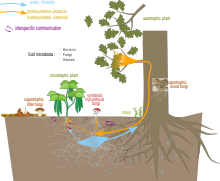Mixotroph
A mixotroph is an organism that can use a mix of different sources of energy and carbon, instead of having a single trophic mode on the continuum from complete autotrophy at one end to heterotrophy at the other. It is estimated that mixotrophs comprise more than half of all microscopic plankton.[1] There are two types of eukaryotic mixotrophs: those with their own chloroplasts, and those with endosymbionts—and those that acquire them through kleptoplasty or by enslaving the entire phototrophic cell.[2]
Possible combinations are photo- and chemotrophy, litho- and organotrophy (osmotrophy, phagotrophy and myzocytosis), auto- and heterotrophy or other combinations of these. Mixotrophs can be either eukaryotic or prokaryotic.[3] They can take advantage of different environmental conditions.[4]
If a trophic mode is obligate, then it is always necessary for sustaining growth and maintenance; if facultative, it can be used as a supplemental source.[3] Some organisms have incomplete Calvin cycles, so they are incapable of fixing carbon dioxide and must use organic carbon sources.
Types of mixotrophy
Organisms may employ mixotrophy obligately or facultatively.
- Obligate mixotrophy: To support growth and maintenance, an organism must utilize both heterotrophic and autotrophic means.
- Obligate autotrophy with facultative heterotrophy: Autotrophy alone is sufficient for growth and maintenance, but heterotrophy may be used as a supplementary strategy when autotrophic energy is not enough, for example, when light intensity is low.
- Facultative autotrophy with obligate heterotrophy: Heterotrophy is sufficient for growth and maintenance, but autotrophy may be used to supplement, for example, when prey availability is very low.
- Facultative mixotrophy: Maintenance and growth may be obtained by heterotrophic or autotrophic means alone, and mixotrophy is used only when necessary.[5]
To characterize the sub-domains within mixotrophy, several very similar categorization schemes have been suggested.
Consider the example of a marine protist with heterotrophic and photosynthetic capabilities: In the breakdown put forward by Jones,[6] there are four mixotrophic groups based on relative roles of phagotrophy and phototrophy.
- A: Heterotrophy (phagotrophy) is the norm, and phototrophy is only used when prey concentrations are limiting.
- B: Phototrophy is the dominant strategy, and phagotrophy is employed as a supplement when light is limiting.
- C: Phototrophy results in substances for both growth and ingestion, phagotrophy is employed when light is limiting.
- D: Phototrophy is most common nutrition type, phagotrophy only used during prolonged dark periods, when light is extremely limiting.
An alternative scheme by Stoeker[7] also takes into account the role of nutrients and growth factors, and includes mixotrophs that have a photosynthetic symbiont or who retain chloroplasts from their prey. This scheme characterizes mixotrophs by their efficiency.
- Type 1: "Ideal mixotrophs" that use prey and sunlight equally well
- Type 2: Supplement phototrophic activity with food consumption
- Type 3: Primarily heterotrophic, use phototrophic activity during times of very low prey abundance.[8]
Microorganisms
- Examples
- Paracoccus pantotrophus is a bacterium that can live chemoorganoheterotrophically, whereby a large variety of organic compounds can be metabolized. Also a facultative chemolithoautotrophic metabolism is possible, as seen in colorless sulfur bacteria (some Thiobacillus), whereby sulfur compounds such as hydrogen sulfide, elemental sulfur, or thiosulfate are oxidized to sulfate. The sulfur compounds serve as electron donors and are consumed to produce ATP. The carbon source for these organisms can be carbon dioxide (autotrophy) or organic carbon (heterotrophy).[9][10][11]
Organoheterotrophy can occur under aerobic or under anaerobic conditions; lithoautotrophy takes place aerobically.[12][13]
Plants

Amongst plants, mixotrophy classically applies to carnivorous, hemi-parasitic and myco-heterotrophic species. However, this characterisation as mixotrophic could be extended to a higher number of clades as research demonstrates that organic forms of nitrogen and phosphorus — such as DNA, proteins, amino-acids or carbohydrates — are also part of the nutrient supplies of a number of plant species.[14]
See also
Notes
- Beware the mixotrophs - they can destroy entire ecosystems 'in a matter of hours'
- Microscopic body snatchers infest our oceans - Phys.org
- Eiler A (December 2006). "Evidence for the Ubiquity of Mixotrophic Bacteria in the Upper Ocean: Implications and Consequences". Appl Environ Microbiol. 72 (12): 7431–7. doi:10.1128/AEM.01559-06. PMC 1694265. PMID 17028233.
- Katechakis A, Stibor H (July 2006). "The mixotroph Ochromonas tuberculata may invade and suppress specialist phago- and phototroph plankton communities depending on nutrient conditions". Oecologia. 148 (4): 692–701. doi:10.1007/s00442-006-0413-4. PMID 16568278.
- Schoonhoven, Erwin (January 19, 2000). "Ecophysiology of Mixotrophs" (PDF). Thesis.
- Jones, H.J.L. (1997). "A classification of mixotrophic protists based on their behaviour". Freshwater Biology. 37: 35–43. doi:10.1046/j.1365-2427.1997.00138.x.
- Stoecker, D.K. (1998). "Conceptual models of mixotrophy in planktonic protists and some ecological and evolutionary implications". European Journal of Protistology. 34 (3): 281–290. doi:10.1016/s0932-4739(98)80055-2.
- Tarangkoon, Woraporn (29 April 2010). "Mixtrophic Protists among Marine Ciliates and Dinoflagellates: Distribution, Physiology and Ecology" (PDF). Thesis.
- Libes, Susan M. (2009). Introduction to marine biogeochemistry (2 ed.). Academic Press. p. 192. ISBN 978-0-7637-5345-0.
- Dworkin, Martin (2006). The Prokaryotes: Ecophysiology and biochemistry. 2 (3rd ed.). Springer. p. 988. ISBN 978-0-387-25492-0.
- Lengeler, Joseph W.; Drews, Gerhart; Schlegel, Hans Günter (1999). Biology of the Prokaryotes. Georg Thieme Verlag. p. 238. ISBN 978-3-13-108411-8.
- Bartosik D, Sochacka M, Baj J (July 2003). "Identification and Characterization of Transposable Elements of Paracoccus pantotrophus". J Bacteriol. 185 (13): 3753–63. doi:10.1128/JB.185.13.3753-3763.2003. PMC 161580. PMID 12813068.
- Friedrich, Cornelius G.; et al. (2007). "Redox Control of Chemotrophic Sulfur Oxidation of Paracoccus pantotrophus". Microbial Sulfur Metabolism. Springer. pp. 139–150. PDF
- Schmidt, Susanne; John A. Raven; Chanyarat Paungfoo-Lonhienne (2013). "The mixotrophic nature of photosynthetic plants". Functional Plant Biology. 40 (5): 425. doi:10.1071/FP13061. ISSN 1445-4408.
External links
- Troost TA, Kooi BW, Kooijman SA (February 2005). "When do mixotrophs specialize? Adaptive dynamics theory applied to a dynamic energy budget model". Math Biosci. 193 (2): 159–82. doi:10.1016/j.mbs.2004.06.010. PMID 15748728.
- Sanders, Robert W. Mixotrophic Nutrition of Phytoplankton: Venus Fly Traps of the microbial world. Temple University.